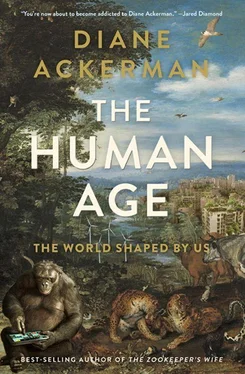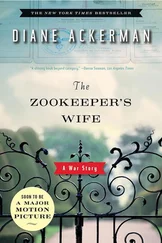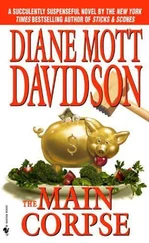Monk Seal Hideaway
Anthology
The Book of Love (with Jeanne Mackin)

W. W. NORTON & COMPANY
NEW YORK • LONDON
Copyright © 2014 by Diane Ackerman
All rights reserved
First Edition
For information about permission to reproduce selections from this book, write to Permissions, W. W. Norton & Company, Inc., 500 Fifth Avenue, New York, NY 10110
For information about special discounts for bulk purchases, please contact W. W. Norton Special Sales at specialsales@wwnorton.comor 800-233-4830
Book design by Jam design
Production manager: Julia Druskin
ISBN 978-0-393-24074-0
ISBN 978-0-393-24584-4 (e-book)
W. W. Norton & Company, Inc.
500 Fifth Avenue, New York, N.Y. 10110
www.wwnorton.com
W. W. Norton & Company Ltd.
Castle House, 75/76 Wells Street, London W1T 3QT
Humans have cleared so much forest over the past 75 years that the orangutan population has plummeted by 80 percent. The International Union for Conservation of Nature lists Borneo orangutans as endangered, and Sumatran orangs as critically endangered, with only about ten years left for the entire species. One hundred million acres of Indonesian rainforest vanished during Suharto’s reign (1921–2008), and regional timber barons have been plundering the forests even faster since then for mahogany, ebony, teak, and other exotic woods. Then there’s palm oil, which is used in rayon viscose and many other products that include the words “palm kernel oil,” “palmate,” or “palmitate” in their ingredients. Once you start looking, it’s startling how many foods, shampoos, toothpaste, soaps, makeup, and other products use palm oil. Orangutan Outreach encourages people to boycott all palm oil–laced products, and dozens of multinational companies (McDonald’s, Pepsi, et al.) have agreed, for the sake of the rainforests.
The term “Anthropocene” was coined by the aquatic ecologist Eugene Stoermer (Emeritus, University of Michigan), who used it at a conference, and Paul Crutzen, who currently works at the Department of Atmospheric Chemistry at the Max Planck Institute in Mainz, Germany; the Scripps Institution of Oceanography at the University of California, San Diego; and Seoul National University in South Korea.
http://www.bbc.co.uk/news/world-15391515.
“Nature,” as E. O. Wilson defines it in The Creation (New York: W. W. Norton, 2006), includes “all on planet Earth that has no need of us and can stand alone” (15).
The website launched on January 8, 2012, and over six hundred skaters at rinks across the continent began reporting.
Extreme weather and climate change: The evidence, already overwhelming, continues to mount. When climate scientists in Copenhagen examined the tide and hurricane history since 1923, they found an ominous link between the fever of the oceans and the number and ferocity of hurricanes. Warmer seas provoke higher tides and whip up more violent cyclones. For ninety years, triggered by the warming climate, more hurricanes have lashed our coastlines and spun fiercer winds. James Hansen of NASA’s Goddard Institute for Space Studies revealed that from 1951 to 1980 only 1 percent of the planet was stricken with weather extremes (outlandish heat, rain, or drought), but between 1980 and 2012 the figure ballooned to 10 percent of the planet. At that rate, he explained, in the next decade, extreme weather will plague about 17 percent of the world. Because it’s important that we actually see climate change unfolding around us, and feel how it touches us personally, the lively online conservation site 350.org hosted “a day of global action” on which people around the world highlighted their local evidence of climate change. At daybreak in the Marshall Islands, there was a demonstration on a diminishing coral reef. In Dakar, Senegal, people marked out the margins of storm surges. In Australia, people hosted a “dry creek regatta” showcasing a ruinous drought. In Chamonix, France, climbers marked where the Alpine glaciers had melted. “Connect the dots” was the theme. See 350.org, if you want to participate in inspired feats of environmental activism.
In Earthmasters: The Dawn of the Age of Climate Engineering , Clive Hamilton makes the point that in the United States, climate change used to be a bipartisan concern, but conservative activists have lumped global warming with gun control and abortion rights as part of a scurrilous liberal agenda, not something apolitical and innately global but a position the liberals have cooked up. Knowing whether someone believes in global warming or not, you can safely guess his or her politics. As one Republican meteorologist noted, it’s become “a bizarre litmus test for conservatism.” And so they deny the science supporting it on political grounds, which makes no sense at all.
A cringe-inducing example of that was when President George W. Bush, at the G8 Summit in 2008, having rejected climate change targets, turned back to his colleagues as he was leaving the closing session, raised a defiant fist, and said light-heartedly, “Good-bye from the world’s biggest polluter.” http://www.independent.co.uk/news/world/politics/bush-to-g8-goodbye-from-the-worlds-biggest-polluter-863911.html.
Patrick Blanc, The Vertical Garden: From Nature to the City (New York: W. W. Norton, 2012), 76.
Bill McKibben, “Nature’s independence”: Bill McKibben, The End of Nature (New York: Random House, 2006), 58.
A python can open its jaws wide as a commodious drawer. But how does it digest something that large? By becoming larger itself. Every time a python eats, its heart, liver, and intestines nearly double in size. Scientists are studying the fatty acids of pythons (which seem to be involved) for potential heart drugs for humans.
Some catastrophes can offer bright sides, even the infestation of pythons in the Everglades. I loved biking on paved roadways through Shark Valley before 2000, when the ’Glades still twitched and thronged with wildlife. But a superfluity of raccoons kept raiding the nests of turtles, birds, and gators, eating their eggs and threatening their future. Burmese pythons happen to love the tang of raccoons, and now, as the raccoon population drops, more turtle, bird, and gator eggs can hatch. (However, that doesn’t offset the python’s impact on a once-lavish ecosystem.)
Many plants may be going extinct, but we’re also gathering together domestic, exotic, and native species in novel ecosystems. See R. J. Hobbs et al., “Novel Ecosystems: Implications for Conservation and Restoration,” Trends in Ecology and Evolution 24 (2009): 599–605.
Plankton got their name from the Greek word for “wandering,” because they drift helplessly on the current.
Plankton (plants), at the bottom, are eaten by zooplankton (animals); krill, fish, and other sea creatures eat the zooplankton.
Jon Mooallem, Wild Ones (New York: Penguin, 2013), 206.
The navy may be phasing out dolphin combatants, but according to a National Resources Defense Council study, the United States has been using unsafe sonar in training exercises off the coast of California that has harmed 2.8 million marine mammals over the past five years. See Brenda Peterson, “Stop U.S. Navy War on Whales,” Huffington Post , March 14, 2014.
Читать дальше













